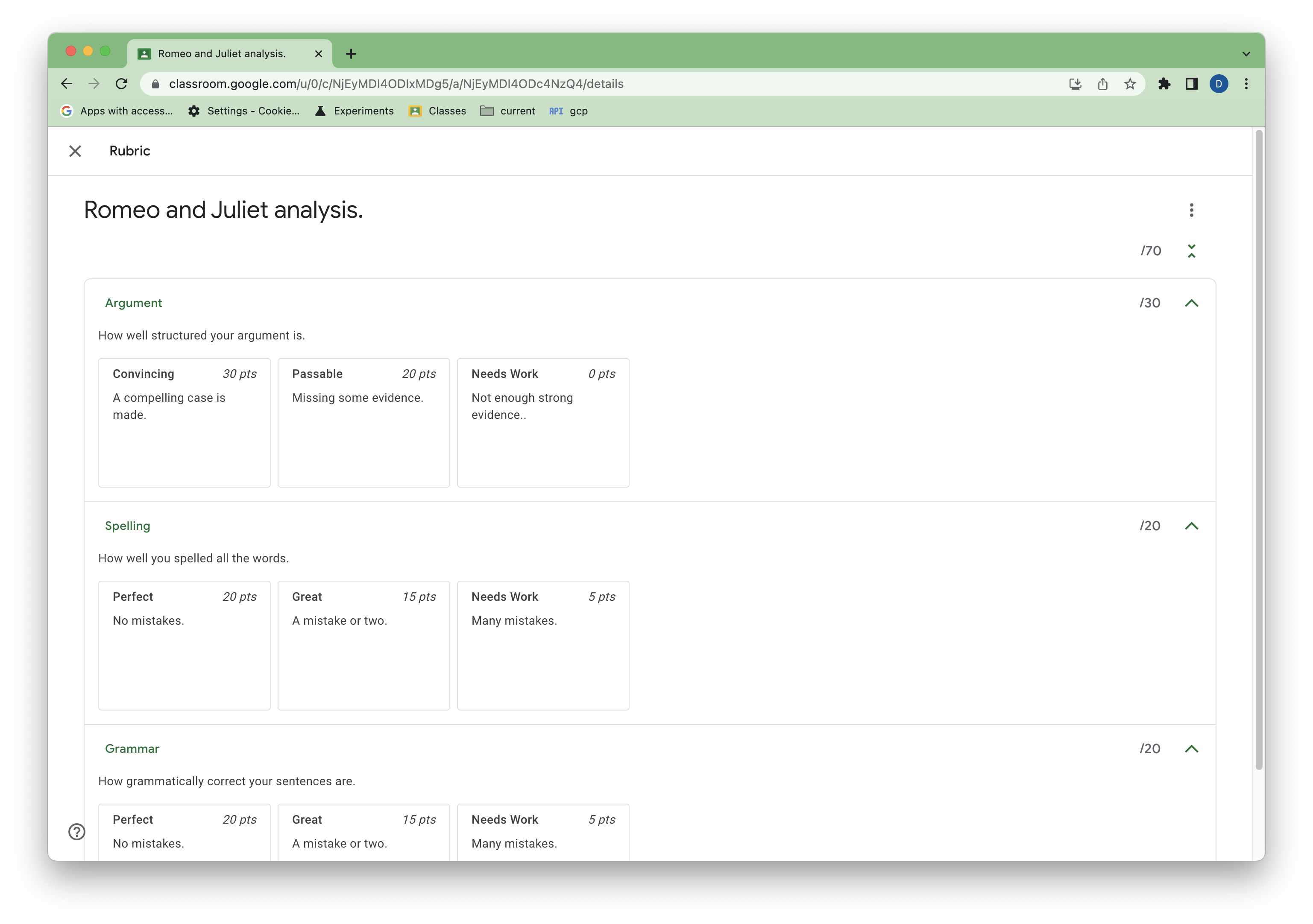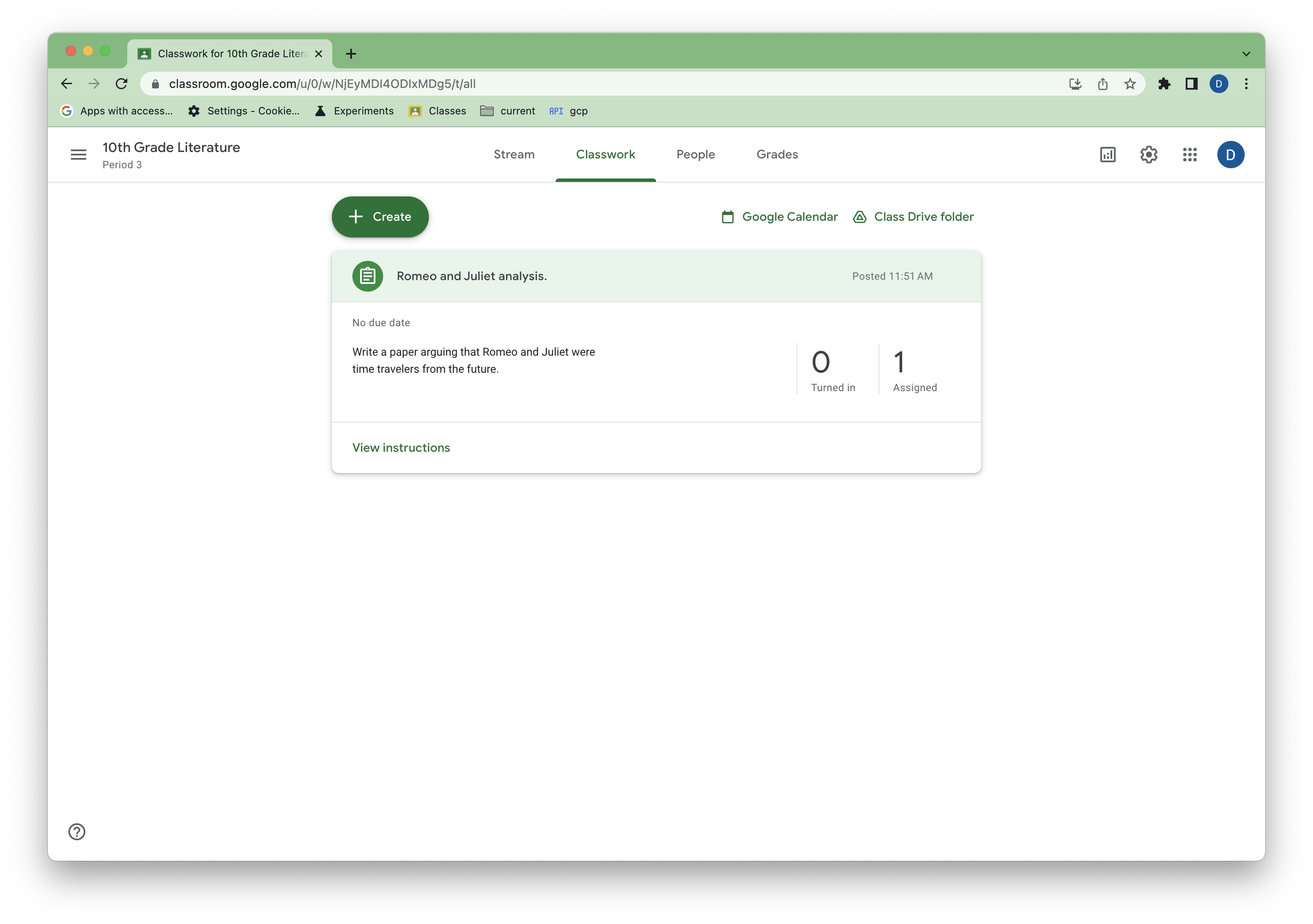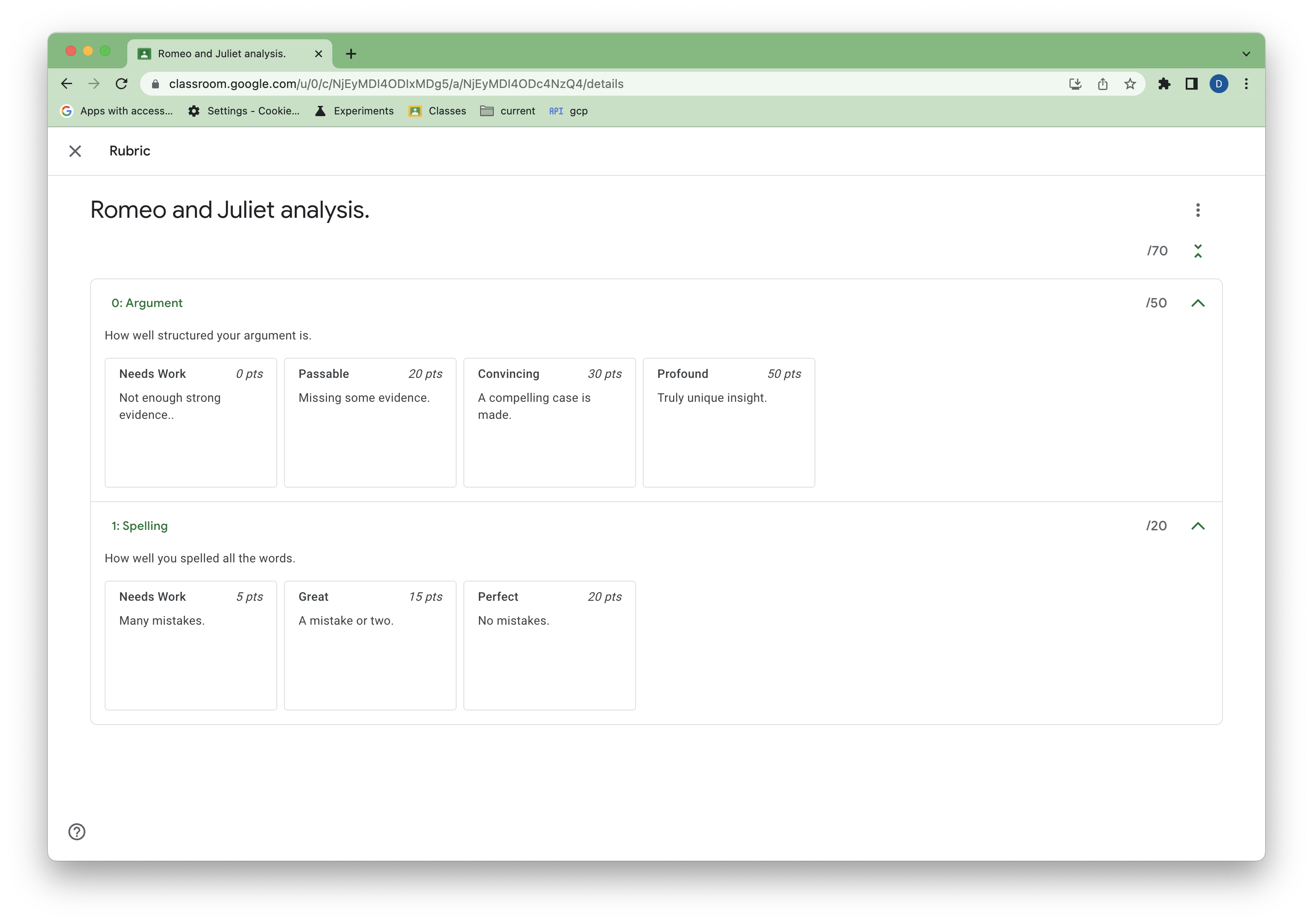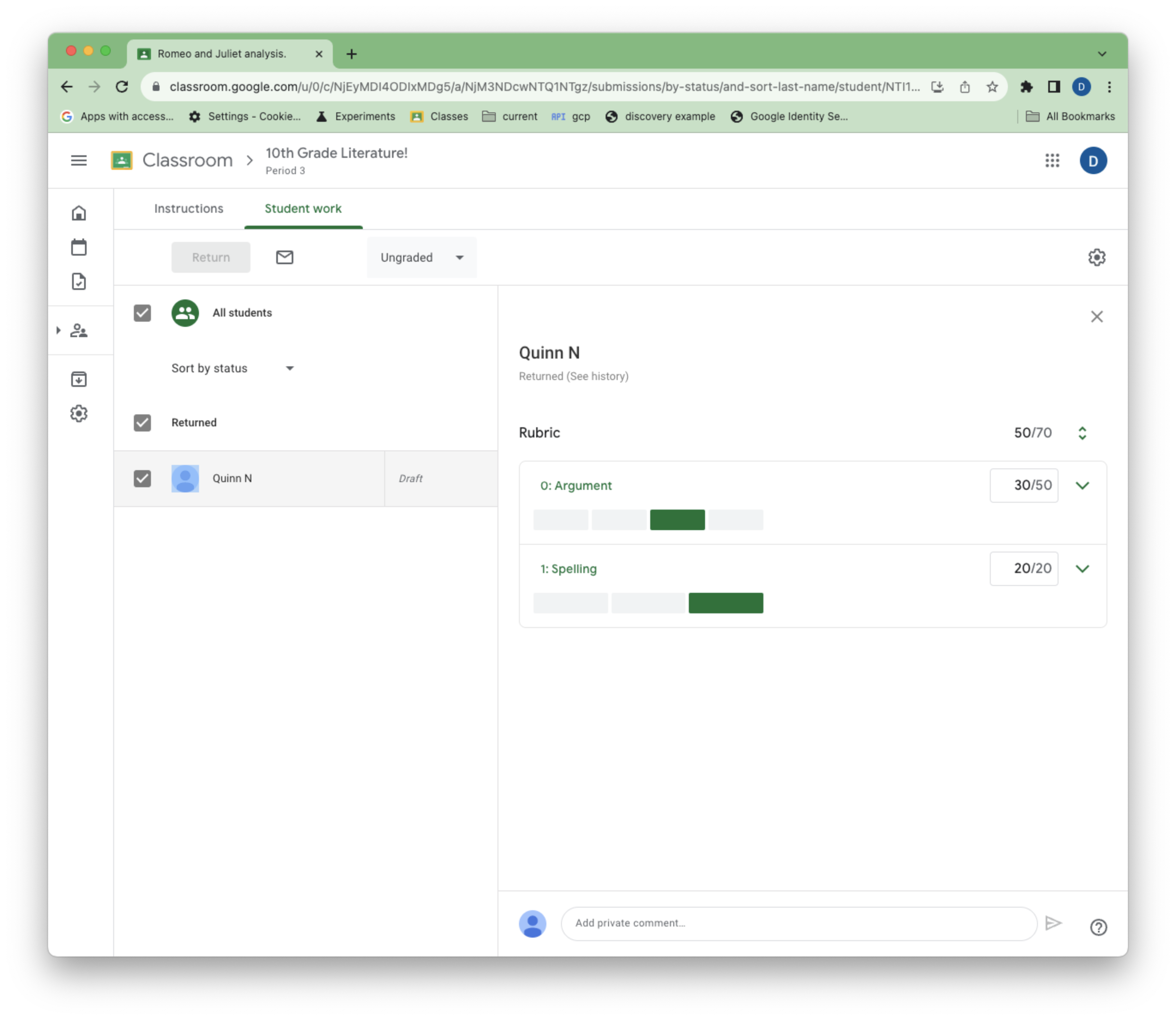rubric คือเทมเพลตที่ครูใช้ได้เมื่อให้คะแนนงานที่นักเรียนส่ง
Classroom API ช่วยให้คุณดำเนินการในนามของครูเพื่อจัดการเกณฑ์การให้คะแนนเหล่านี้ รวมถึงอ่านคะแนนตามเกณฑ์การให้คะแนนในงานที่นักเรียนส่งได้
 รูปที่ 1 มุมมองของเกณฑ์การให้คะแนนตัวอย่างในงานของ Classroom
รูปที่ 1 มุมมองของเกณฑ์การให้คะแนนตัวอย่างในงานของ Classroom
คู่มือนี้อธิบายแนวคิดพื้นฐานและฟังก์ชันการทำงานของ Rubrics API ดูโครงสร้างทั่วไปของเกณฑ์การให้คะแนนและวิธีให้คะแนนตามเกณฑ์ใน UI ของ Classroom ได้ที่บทความในศูนย์ช่วยเหลือเหล่านี้
ข้อกำหนดเบื้องต้น
คู่มือนี้จะถือว่าคุณมีสิ่งต่อไปนี้
- Python 3.8.6 ขึ้นไป
- เครื่องมือจัดการแพ็กเกจ pip
- โปรเจ็กต์ Google Cloud
- บัญชี Google Workspace for Education ที่เปิดใช้ Google Classroom และมีใบอนุญาต Google Workspace for Education Plus ที่มอบหมายให้ คุณสามารถขอบัญชีเดโมนักพัฒนาแอปที่อัปเกรดแล้วได้หากยังไม่มี
- ชั้นเรียนทดสอบที่มีบัญชีนักเรียนทดสอบอย่างน้อย 1 บัญชี หากไม่มีชั้นเรียนใน Classroom ที่ใช้ทดสอบได้ ให้สร้างชั้นเรียนใน UI แล้วเพิ่มนักเรียนทดสอบ
ให้สิทธิ์ข้อมูลเข้าสู่ระบบสำหรับแอปพลิเคชันบนเดสก์ท็อป
หากต้องการตรวจสอบสิทธิ์ในฐานะผู้ใช้ปลายทางและเข้าถึงข้อมูลผู้ใช้ในแอป คุณต้องสร้างรหัสไคลเอ็นต์ OAuth 2.0 อย่างน้อย 1 รายการ รหัสไคลเอ็นต์ใช้เพื่อระบุ แอปเดี่ยวไปยังเซิร์ฟเวอร์ OAuth ของ Google หากแอปทำงานบนหลายแพลตฟอร์ม คุณต้องสร้างรหัสไคลเอ็นต์แยกต่างหากสำหรับแต่ละแพลตฟอร์ม
- ไปที่หน้าข้อมูลเข้าสู่ระบบของ Google Cloud ใน คอนโซล Google Cloud
- คลิกสร้างข้อมูลเข้าสู่ระบบ > รหัสไคลเอ็นต์ OAuth
- คลิกประเภทแอปพลิเคชัน > แอปเดสก์ท็อป
- ในช่องชื่อ ให้พิมพ์ชื่อของข้อมูลเข้าสู่ระบบ ชื่อนี้จะแสดงใน Google Cloud Console เท่านั้น เช่น "ไคลเอ็นต์รูบริก"
- คลิกสร้าง หน้าจอไคลเอ็นต์ OAuth ที่สร้างขึ้นจะปรากฏขึ้น โดยแสดงรหัสไคลเอ็นต์และรหัสลับไคลเอ็นต์ใหม่
- คลิกดาวน์โหลด JSON แล้วคลิกตกลง ข้อมูลเข้าสู่ระบบที่สร้างขึ้นใหม่จะปรากฏในส่วนรหัสไคลเอ็นต์ OAuth 2.0
- บันทึกไฟล์ JSON ที่ดาวน์โหลดเป็น
credentials.jsonแล้วย้ายไฟล์ไปยัง ไดเรกทอรีการทำงาน - คลิกสร้างข้อมูลเข้าสู่ระบบ > คีย์ API แล้วจดคีย์ API ไว้
ดูข้อมูลเพิ่มเติมได้ที่สร้างข้อมูลเข้าสู่ระบบ
กำหนดค่าขอบเขต OAuth
คุณอาจต้องกำหนดค่าขอบเขตเพิ่มเติม ทั้งนี้ขึ้นอยู่กับขอบเขต OAuth ที่มีอยู่ของโปรเจ็กต์
- ไปที่หน้าจอขอความยินยอม OAuth
- คลิกแก้ไขแอป > บันทึกและดำเนินการต่อ เพื่อไปยังหน้าจอขอบเขต
- คลิกเพิ่มหรือนำขอบเขตออก
- เพิ่มขอบเขตต่อไปนี้หากยังไม่มี
https://www.googleapis.com/auth/classroom.coursework.studentshttps://www.googleapis.com/auth/classroom.courses
- จากนั้นคลิกอัปเดต > บันทึกและดำเนินการต่อ > บันทึกและดำเนินการต่อ > กลับไปที่แดชบอร์ด
ดูข้อมูลเพิ่มเติมได้ที่กำหนดค่าหน้าจอขอความยินยอม OAuth
ขอบเขต classroom.coursework.students ช่วยให้สิทธิ์การอ่านและการเขียนใน
เกณฑ์การให้คะแนน (พร้อมกับสิทธิ์เข้าถึง CourseWork) และขอบเขต classroom.courses
อนุญาตให้อ่านและเขียนหลักสูตร
ขอบเขตที่จำเป็นสำหรับเมธอดหนึ่งๆ จะแสดงอยู่ในเอกสารอ้างอิง
ของเมธอดนั้น ดูตัวอย่างได้ที่courses.courseWork.rubrics.createขอบเขตการให้สิทธิ์
คุณดูขอบเขตทั้งหมดของ Classroom ได้ในขอบเขต OAuth 2.0 สำหรับ Google
APIs
กำหนดค่าตัวอย่าง
ในไดเรกทอรีการทำงาน ให้ติดตั้งไลบรารีของไคลเอ็นต์ Google สำหรับ Python โดยทำดังนี้
pip install --upgrade google-api-python-client google-auth-httplib2 google-auth-oauthlib
สร้างไฟล์ชื่อ main.py ซึ่งสร้างไลบรารีของไคลเอ็นต์และให้สิทธิ์
ผู้ใช้ โดยใช้คีย์ API แทน YOUR_API_KEY ดังนี้
import json
import os.path
from google.auth.transport.requests import Request
from google.oauth2.credentials import Credentials
from google_auth_oauthlib.flow import InstalledAppFlow
from googleapiclient.discovery import build
from googleapiclient.errors import HttpError
# If modifying these scopes, delete the file token.json.
SCOPES = ['https://www.googleapis.com/auth/classroom.courses',
'https://www.googleapis.com/auth/classroom.coursework.students']
def build_authenticated_service(api_key):
"""Builds the Classroom service."""
creds = None
# The file token.json stores the user's access and refresh tokens, and is
# created automatically when the authorization flow completes for the first
# time.
if os.path.exists('token.json'):
creds = Credentials.from_authorized_user_file('token.json', SCOPES)
# If there are no (valid) credentials available, let the user log in.
if not creds or not creds.valid:
if creds and creds.expired and creds.refresh_token:
creds.refresh(Request())
else:
flow = InstalledAppFlow.from_client_secrets_file(
'credentials.json', SCOPES)
creds = flow.run_local_server(port=0)
# Save the credentials for the next run.
with open('token.json', 'w') as token:
token.write(creds.to_json())
try:
# Build the Classroom service.
service = build(
serviceName="classroom",
version="v1",
credentials=creds,
discoveryServiceUrl=f"https://classroom.googleapis.com/$discovery/rest?labels=DEVELOPER_PREVIEW&key={api_key}")
return service
except HttpError as error:
print('An error occurred: %s' % error)
if __name__ == '__main__':
service = build_authenticated_service(YOUR_API_KEY)
เรียกใช้สคริปต์โดยใช้ python main.py ระบบจะแจ้งให้คุณลงชื่อเข้าใช้และ
ให้ความยินยอมสำหรับขอบเขต OAuth
สร้างงาน
โดยระบบจะเชื่อมโยงรูบริกกับงานหรือCourseWork และจะมีความหมายเฉพาะในบริบทของCourseWorkนั้นเท่านั้น สร้างรูบริกได้เฉพาะโปรเจ็กต์ Google Cloud ที่สร้างCourseWorkรายการหลัก สำหรับวัตถุประสงค์ของคู่มือนี้ ให้สร้างCourseWorkงานใหม่ด้วยสคริปต์
เพิ่มรายการต่อไปนี้ไปยัง main.py
def get_latest_course(service):
"""Retrieves the last created course."""
try:
response = service.courses().list(pageSize=1).execute()
courses = response.get("courses", [])
if not courses:
print("No courses found. Did you remember to create one in the UI?")
return
course = courses[0]
return course
except HttpError as error:
print(f"An error occurred: {error}")
return error
def create_coursework(service, course_id):
"""Creates and returns a sample coursework."""
try:
coursework = {
"title": "Romeo and Juliet analysis.",
"description": """Write a paper arguing that Romeo and Juliet were
time travelers from the future.""",
"workType": "ASSIGNMENT",
"state": "PUBLISHED",
}
coursework = service.courses().courseWork().create(
courseId=course_id, body=coursework).execute()
return coursework
except HttpError as error:
print(f"An error occurred: {error}")
return error
ตอนนี้ให้อัปเดต main.py เพื่อดึงข้อมูล course_id ของคลาสทดสอบที่คุณเพิ่งสร้าง
สร้างงานตัวอย่างใหม่ และดึงข้อมูล coursework_id ของงาน
if __name__ == '__main__':
service = build_authenticated_service(YOUR_API_KEY)
course = get_latest_course(service)
course_id = course.get("id")
course_name = course.get("name")
print(f"'{course_name}' course ID: {course_id}")
coursework = create_coursework(service, course_id)
coursework_id = coursework.get("id")
print(f"Assignment created with ID {coursework_id}")
#TODO(developer): Save the printed course and coursework IDs.
บันทึกcourse_idและcoursework_id ต้องใช้ข้อมูลเหล่านี้สำหรับการดำเนินการ CRUD ทั้งหมดของรูบริก
ตอนนี้คุณควรมีตัวอย่าง CourseWork ใน Classroom แล้ว
 รูปที่ 2 มุมมองของงานตัวอย่างใน Classroom
รูปที่ 2 มุมมองของงานตัวอย่างใน Classroom
ตรวจสอบสิทธิ์ของผู้ใช้
การสร้างและอัปเดตรูบริกกำหนดให้ทั้งผู้ใช้ที่ส่งคำขอและเจ้าของหลักสูตรที่เกี่ยวข้องต้องได้รับมอบหมายใบอนุญาต Google Workspace for Education Plus Classroom รองรับปลายทางการมีสิทธิ์ของผู้ใช้เพื่อช่วยให้นักพัฒนาแอปกำหนดความสามารถที่ผู้ใช้มีสิทธิ์เข้าถึงได้
อัปเดตและเรียกใช้ main.py เพื่อยืนยันว่าบัญชีทดสอบของคุณมีสิทธิ์เข้าถึงความสามารถของ
เครื่องมือให้คะแนน
if __name__ == '__main__':
service = build_authenticated_service(YOUR_API_KEY)
capability = service.userProfiles().checkUserCapability(
userId='me',
# Specify the preview version. checkUserCapability is
# supported in V1_20240930_PREVIEW and later.
previewVersion="V1_20240930_PREVIEW",
capability="CREATE_RUBRIC").execute()
if not capability.get('allowed'):
print('User ineligible for rubrics creation.')
# TODO(developer): in a production app, this signal could be used to
# proactively hide any rubrics related features from users or encourage
# them to upgrade to the appropriate license.
else:
print('User eligible for rubrics creation.')
สร้างเกณฑ์การให้คะแนน
ตอนนี้คุณก็พร้อมที่จะเริ่มจัดการเกณฑ์การให้คะแนนแล้ว
คุณสร้างเกณฑ์การให้คะแนนใน CourseWork ด้วยการเรียก create() ที่มีออบเจ็กต์เกณฑ์การให้คะแนนแบบเต็ม โดยจะละเว้นพร็อพเพอร์ตี้รหัสสำหรับเกณฑ์และระดับ (ระบบจะสร้างพร็อพเพอร์ตี้เหล่านี้เมื่อสร้าง)
เพิ่มฟังก์ชันต่อไปนี้ลงใน main.py
def create_rubric(service, course_id, coursework_id):
"""Creates an example rubric on a coursework."""
try:
body = {
"criteria": [
{
"title": "Argument",
"description": "How well structured your argument is.",
"levels": [
{"title": "Convincing",
"description": "A compelling case is made.", "points": 30},
{"title": "Passable",
"description": "Missing some evidence.", "points": 20},
{"title": "Needs Work",
"description": "Not enough strong evidence..", "points": 0},
]
},
{
"title": "Spelling",
"description": "How well you spelled all the words.",
"levels": [
{"title": "Perfect",
"description": "No mistakes.", "points": 20},
{"title": "Great",
"description": "A mistake or two.", "points": 15},
{"title": "Needs Work",
"description": "Many mistakes.", "points": 5},
]
},
{
"title": "Grammar",
"description": "How grammatically correct your sentences are.",
"levels": [
{"title": "Perfect",
"description": "No mistakes.", "points": 20},
{"title": "Great",
"description": "A mistake or two.", "points": 15},
{"title": "Needs Work",
"description": "Many mistakes.", "points": 5},
]
},
]
}
rubric = service.courses().courseWork().rubrics().create(
courseId=course_id, courseWorkId=coursework_id, body=body
).execute()
print(f"Rubric created with ID {rubric.get('id')}")
return rubric
except HttpError as error:
print(f"An error occurred: {error}")
return error
จากนั้นอัปเดตและเรียกใช้ main.py เพื่อสร้างเกณฑ์การให้คะแนนตัวอย่าง โดยใช้รหัส Course
และ CourseWork จากก่อนหน้านี้
if __name__ == '__main__':
service = build_authenticated_service(YOUR_API_KEY)
capability = service.userProfiles().checkUserCapability(
userId='me',
# Specify the preview version. checkUserCapability is
# supported in V1_20240930_PREVIEW and later.
previewVersion="V1_20240930_PREVIEW",
capability="CREATE_RUBRIC").execute()
if not capability.get('allowed'):
print('User ineligible for rubrics creation.')
# TODO(developer): in a production app, this signal could be used to
# proactively hide any rubrics related features from users or encourage
# them to upgrade to the appropriate license.
else:
rubric = create_rubric(service, YOUR_COURSE_ID, YOUR_COURSEWORK_ID)
print(json.dumps(rubric, indent=4))
ข้อควรทราบเกี่ยวกับการแสดงเกณฑ์การให้คะแนน
- ลำดับเกณฑ์และระดับจะแสดงใน UI ของ Classroom
- ระดับที่มีคะแนน (ระดับที่มีพร็อพเพอร์ตี้
points) ต้องจัดเรียงตามคะแนน จากน้อยไปมากหรือมากไปน้อย (จัดเรียงแบบสุ่มไม่ได้) - ครูสามารถจัดเรียงเกณฑ์และระดับคะแนนใหม่ได้ (แต่จะจัดเรียงระดับที่ไม่มีคะแนนไม่ได้) ใน UI และการดำเนินการดังกล่าวจะเปลี่ยนลำดับในข้อมูล
ดูข้อควรระวังเพิ่มเติมเกี่ยวกับโครงสร้างเกณฑ์การให้คะแนนได้ที่ข้อจำกัด
คุณควรเห็นรูบริกในงานที่ UI
 รูปที่ 3 มุมมองของเกณฑ์การให้คะแนนตัวอย่างในงานของ Classroom
รูปที่ 3 มุมมองของเกณฑ์การให้คะแนนตัวอย่างในงานของ Classroom
อ่านเกณฑ์การให้คะแนน
คุณอ่านเกณฑ์การให้คะแนนได้ด้วยวิธีการ list() และ get() มาตรฐาน
งานจะมีเกณฑ์การให้คะแนนได้ไม่เกิน 1 รายการ ดังนั้น list() อาจดู
ไม่เป็นไปตามสัญชาตญาณ แต่ก็มีประโยชน์หากคุณยังไม่มีรหัสเกณฑ์การให้คะแนน หากไม่มีรูบริกที่เชื่อมโยงกับ CourseWork คำตอบของ list() จะว่างเปล่า
เพิ่มฟังก์ชันต่อไปนี้ลงใน main.py
def get_rubric(service, course_id, coursework_id):
"""
Get the rubric on a coursework. There can only be at most one.
Returns null if there is no rubric.
"""
try:
response = service.courses().courseWork().rubrics().list(
courseId=course_id, courseWorkId=coursework_id
).execute()
rubrics = response.get("rubrics", [])
if not rubrics:
print("No rubric found for this assignment.")
return
rubric = rubrics[0]
return rubric
except HttpError as error:
print(f"An error occurred: {error}")
return error
อัปเดตและเรียกใช้ main.py เพื่อดึงเกณฑ์การให้คะแนนที่คุณเพิ่ม
if __name__ == '__main__':
service = build_authenticated_service(YOUR_API_KEY)
rubric = get_rubric(service, YOUR_COURSE_ID, YOUR_COURSEWORK_ID)
print(json.dumps(rubric, indent=4))
#TODO(developer): Save the printed rubric ID.
โปรดสังเกตพร็อพเพอร์ตี้ id ในรูบริกสำหรับขั้นตอนในภายหลัง
Get() จะทำงานได้ดีเมื่อคุณมีรหัสรูบริก การใช้ get() ในฟังก์ชัน
แทนอาจมีลักษณะดังนี้
def get_rubric(service, course_id, coursework_id, rubric_id):
"""
Get the rubric on a coursework. There can only be at most one.
Returns a 404 if there is no rubric.
"""
try:
rubric = service.courses().courseWork().rubrics().get(
courseId=course_id,
courseWorkId=coursework_id,
id=rubric_id
).execute()
return rubric
except HttpError as error:
print(f"An error occurred: {error}")
return error
การติดตั้งใช้งานนี้จะแสดงผล 404 หากไม่มีรูบริก
อัปเดตเกณฑ์การให้คะแนน
การอัปเดตเกณฑ์การให้คะแนนจะทำได้ด้วยการเรียกใช้ patch() เนื่องจากโครงสร้างของรูบริกมีความซับซ้อน
การอัปเดตจึงต้องทำตามรูปแบบการอ่าน-แก้ไข-เขียน
โดยจะมีการแทนที่พร็อพเพอร์ตี้ criteria ทั้งหมด
กฎการอัปเดตมีดังนี้
- เกณฑ์หรือระดับที่เพิ่มโดยไม่มีรหัสถือเป็นการเพิ่ม
- ระบบจะถือว่าเกณฑ์หรือระดับที่หายไปจากก่อนหน้านี้เป็นการลบ
- เกณฑ์หรือระดับที่มีรหัสอยู่แล้วแต่มีการแก้ไขข้อมูลจะถือเป็นการแก้ไข ส่วนพร็อพเพอร์ตี้ที่ไม่ได้แก้ไขจะยังคงเหมือนเดิม
- เกณฑ์หรือระดับที่ระบุพร้อมรหัสใหม่หรือรหัสที่ไม่รู้จักจะถือเป็นข้อผิดพลาด
- ลำดับของเกณฑ์และระดับใหม่ถือเป็นลำดับ UI ใหม่ (โดยมีข้อจำกัดที่กล่าวถึงข้างต้น)
เพิ่มฟังก์ชันสำหรับการอัปเดตเกณฑ์การให้คะแนน
def update_rubric(service, course_id, coursework_id, rubric_id, body):
"""
Updates the rubric on a coursework.
"""
try:
rubric = service.courses().courseWork().rubrics().patch(
courseId=course_id,
courseWorkId=coursework_id,
id=rubric_id,
body=body,
updateMask='criteria'
).execute()
return rubric
except HttpError as error:
print(f"An error occurred: {error}")
return error
ในตัวอย่างนี้ มีการระบุฟิลด์ criteria เพื่อแก้ไขด้วย
updateMask
จากนั้นแก้ไข main.py เพื่อทำการเปลี่ยนแปลงสำหรับกฎการอัปเดตที่กล่าวถึงข้างต้นแต่ละข้อ
if __name__ == '__main__':
service = build_authenticated_service(YOUR_API_KEY)
capability = service.userProfiles().checkUserCapability(
userId='me',
# Specify the preview version. checkUserCapability is
# supported in V1_20240930_PREVIEW and later.
previewVersion="V1_20240930_PREVIEW",
capability="CREATE_RUBRIC").execute()
if not capability.get('allowed'):
print('User ineligible for rubrics creation.')
# TODO(developer): in a production app, this signal could be used to
# proactively hide any rubrics related features from users or encourage
# them to upgrade to the appropriate license.
else:
# Get the latest rubric.
rubric = get_rubric(service, YOUR_COURSE_ID, YOUR_COURSEWORK_ID)
criteria = rubric.get("criteria")
"""
The "criteria" property should look like this:
[
{
"id": "NkEyMdMyMzM2Nxkw",
"title": "Argument",
"description": "How well structured your argument is.",
"levels": [
{
"id": "NkEyMdMyMzM2Nxkx",
"title": "Convincing",
"description": "A compelling case is made.",
"points": 30
},
{
"id": "NkEyMdMyMzM2Nxky",
"title": "Passable",
"description": "Missing some evidence.",
"points": 20
},
{
"id": "NkEyMdMyMzM2Nxkz",
"title": "Needs Work",
"description": "Not enough strong evidence..",
"points": 0
}
]
},
{
"id": "NkEyMdMyMzM2Nxk0",
"title": "Spelling",
"description": "How well you spelled all the words.",
"levels": [...]
},
{
"id": "NkEyMdMyMzM2Nxk4",
"title": "Grammar",
"description": "How grammatically correct your sentences are.",
"levels": [...]
}
]
"""
# Make edits. This example will make one of each type of change.
# Add a new level to the first criteria. Levels must remain sorted by
# points.
new_level = {
"title": "Profound",
"description": "Truly unique insight.",
"points": 50
}
criteria[0]["levels"].insert(0, new_level)
# Remove the last criteria.
del criteria[-1]
# Update the criteria titles with numeric prefixes.
for index, criterion in enumerate(criteria):
criterion["title"] = f"{index}: {criterion['title']}"
# Resort the levels from descending to ascending points.
for criterion in criteria:
criterion["levels"].sort(key=lambda level: level["points"])
# Update the rubric with a patch call.
new_rubric = update_rubric(
service, YOUR_COURSE_ID, YOUR_COURSEWORK_ID, YOUR_RUBRIC_ID, rubric)
print(json.dumps(new_rubric, indent=4))
ตอนนี้การเปลี่ยนแปลงควรแสดงต่อครูใน Classroom แล้ว
 รูปที่ 4 มุมมองของเกณฑ์การให้คะแนนที่อัปเดต
รูปที่ 4 มุมมองของเกณฑ์การให้คะแนนที่อัปเดต
ดูงานที่ส่งซึ่งให้คะแนนตามเกณฑ์การให้คะแนน
ขณะนี้ API ยังไม่สามารถใช้เกณฑ์การให้คะแนนเพื่อให้คะแนนงานที่นักเรียนส่ง แต่คุณ อ่านคะแนนตามเกณฑ์การให้คะแนนของงานที่ส่งซึ่งได้รับการให้คะแนนตามเกณฑ์การให้คะแนนใน UI ของ Classroom ได้
ในฐานะนักเรียนใน UI ของ Classroom ให้ทำงานและส่งงานตัวอย่าง จากนั้นในฐานะครู ให้ให้คะแนนงานโดยใช้เกณฑ์การให้คะแนนด้วยตนเอง
 รูปที่ 5 มุมมองของครูเกี่ยวกับเกณฑ์การให้คะแนนระหว่างการให้คะแนน
รูปที่ 5 มุมมองของครูเกี่ยวกับเกณฑ์การให้คะแนนระหว่างการให้คะแนน
StudentSubmissions ที่ให้คะแนนด้วยรูบริกจะมีพร็อพเพอร์ตี้ใหม่ 2 รายการ
คือ draftRubricGrades และ assignedRubricGrades ซึ่งแสดงถึง
คะแนนและระดับที่ครูเลือกไว้ในระหว่างสถานะการให้คะแนนแบบฉบับร่างและที่มอบหมายตามลำดับ
คุณสามารถใช้วิธี studentSubmissions.get() และ
studentSubmissions.list() ที่มีอยู่เพื่อดูงานที่ส่งซึ่งได้รับการให้คะแนนแล้ว
เพิ่มฟังก์ชันต่อไปนี้ลงใน main.py เพื่อแสดงรายการงานที่นักเรียนส่ง
def get_latest_submission(service, course_id, coursework_id):
"""Retrieves the last submission for an assignment."""
try:
response = service.courses().courseWork().studentSubmissions().list(
courseId = course_id,
courseWorkId = coursework_id,
pageSize=1
).execute()
submissions = response.get("studentSubmissions", [])
if not submissions:
print(
"""No submissions found. Did you remember to turn in and grade
the assignment in the UI?""")
return
submission = submissions[0]
return submission
except HttpError as error:
print(f"An error occurred: {error}")
return error
จากนั้นอัปเดตและเรียกใช้ main.py เพื่อดูคะแนนการส่ง
if __name__ == '__main__':
service = build_authenticated_service(YOUR_API_KEY)
submission = get_latest_submission(
service, YOUR_COURSE_ID, YOUR_COURSEWORK_ID)
print(json.dumps(submission, indent=4))
draftRubricGrades และ assignedRubricGrades มีข้อมูลต่อไปนี้
criterionIdของเกณฑ์การให้คะแนนที่เกี่ยวข้องpointsครูที่ได้รับมอบหมายให้ประเมินเกณฑ์แต่ละรายการ ซึ่งอาจมาจากระดับที่เลือก แต่ครูอาจเขียนทับค่านี้ได้เช่นกันlevelIdของระดับที่เลือกสำหรับเกณฑ์แต่ละรายการ หากครูไม่ได้ เลือกระดับ แต่ยังคงกำหนดคะแนนสำหรับเกณฑ์ ฟิลด์นี้ จะไม่ปรากฏ
รายการเหล่านี้จะมีเฉพาะรายการสำหรับเกณฑ์ที่ครู
เลือกระดับหรือตั้งคะแนนไว้ เช่น หากครูเลือกที่จะโต้ตอบกับเกณฑ์เพียงข้อเดียวในระหว่างการให้คะแนน draftRubricGrades และ assignedRubricGrades จะมีเพียงรายการเดียว แม้ว่ารูบริกจะมีเกณฑ์หลายข้อก็ตาม
ลบเกณฑ์การให้คะแนน
คุณลบรูบริกได้ด้วยคำขอมาตรฐาน delete() โค้ดต่อไปนี้
แสดงฟังก์ชันตัวอย่างเพื่อให้สมบูรณ์ แต่เนื่องจากได้เริ่มให้คะแนนแล้ว
คุณจึงลบเกณฑ์การให้คะแนนปัจจุบันไม่ได้
def delete_rubric(service, course_id, coursework_id, rubric_id):
"""Deletes the rubric on a coursework."""
try:
service.courses().courseWork().rubrics().delete(
courseId=course_id,
courseWorkId=coursework_id,
id=rubric_id
).execute()
except HttpError as error:
print(f"An error occurred: {error}")
return error
ส่งออกและนำเข้าเกณฑ์การให้คะแนน
ครูสามารถส่งออกเกณฑ์การให้คะแนนไปยัง Google Spreadsheets ด้วยตนเองเพื่อนำไปใช้ซ้ำได้
นอกเหนือจากการระบุเกณฑ์การให้คะแนนในโค้ดแล้ว คุณยังสร้างและ
อัปเดตเกณฑ์การให้คะแนนจากชีตที่ส่งออกเหล่านี้ได้โดยการระบุ
sourceSpreadsheetId ในเนื้อหาของเกณฑ์การให้คะแนนแทน criteria
def create_rubric_from_sheet(service, course_id, coursework_id, sheet_id):
"""Creates an example rubric on a coursework."""
try:
body = {
"sourceSpreadsheetId": sheet_id
}
rubric = service.courses().courseWork().rubrics().create(
courseId=course_id, courseWorkId=coursework_id, body=body
).execute()
print(f"Rubric created with ID {rubric.get('id')}")
return rubric
except HttpError as error:
print(f"An error occurred: {error}")
return error
